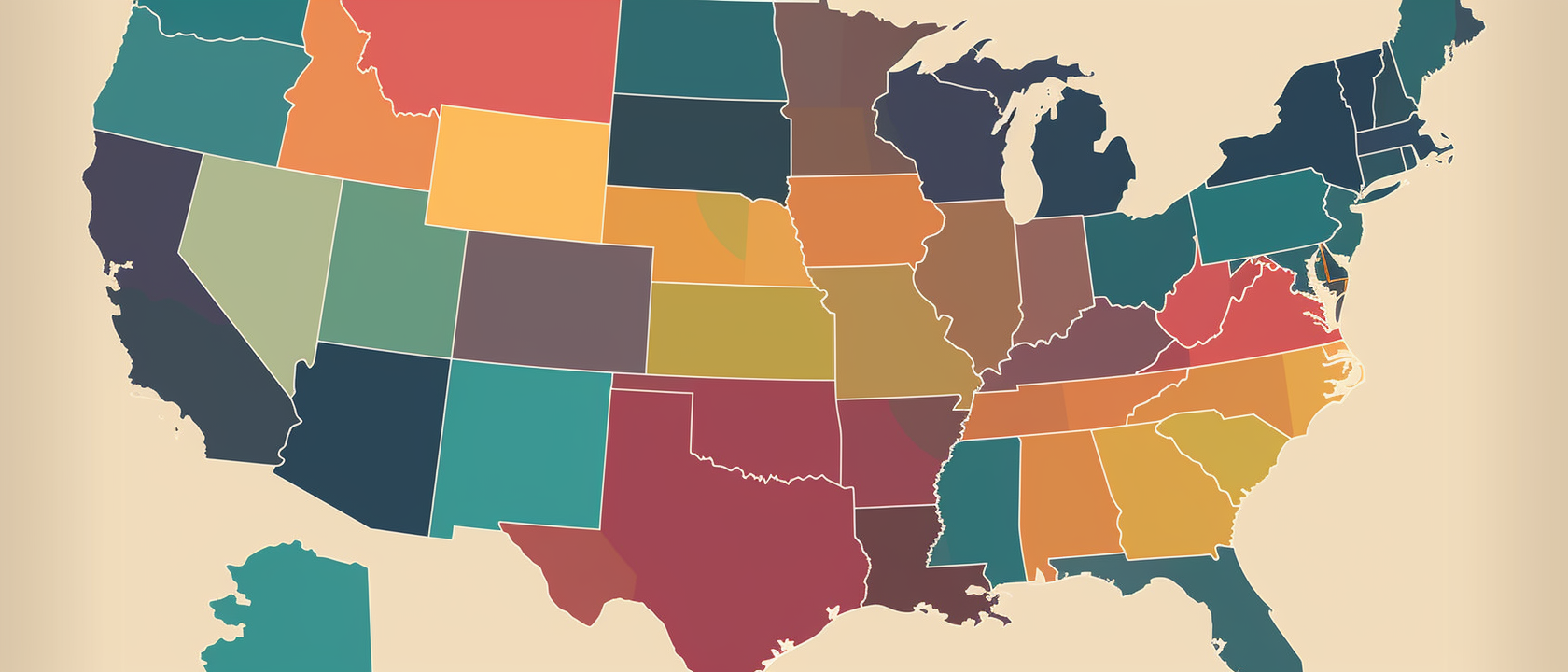
Table of Contents
- Geographic Influence: Economic climates, average incomes, and local regulations contribute to the variation in credit scores from state to state.
- Top Performers: States with the highest credit scores typically exhibit robust economic indicators and sound consumer financial practices.
- Room for Improvement: States with lower credit scores often face challenges like higher unemployment rates or lower average incomes, which can affect residents’ credit management.
- Economic Indicators: A state’s average credit score can act as a barometer for its overall economic health and inform potential policy interventions.
- Personal Impact: While state averages provide context, individual credit scores can diverge significantly, highlighting the importance of personal credit management regardless of geographic trends.
Credit Score Geography 101
There is plenty of geographic disparity in credit scores, and it is important to understand why for both consumers and lenders. Breaking it down represents the broader economic landscape and individual financial health within a region. For consumers, where you live can influence your credit opportunities, as lenders often adjust their approval criteria and interest rates based on regional risk assessments. States with higher average scores might enjoy better average loan terms.
These comparisons can help lenders develop region-specific credit products and risk mitigation strategies. It allows for a more nuanced approach to lending. Credit scores can serve as a financial fingerprint of a region, providing insight into the general creditworthiness of its inhabitants and, by extension, the local economic stability and growth potential.
Beyond the Numbers
There is a lot more than just the statistics when it comes to credit score analysis. It can guide policymakers in identifying areas in need of financial education and economic support, for example, ultimately trying to elevate the financial well-being of their constituents. For individuals, understanding the regional credit score trends can help with credit management, emphasizing that while you’re part of a larger economic system, personal financial habits can help with credit success.
Determining Factors Behind the Numbers
The average credit scores result from a combination of economic conditions and consumer behaviors. Economic variables such as the state’s unemployment rate, median income, and the cost of living can all affect average credit scores. For example, a higher unemployment rate may lead to increased debt and late payments, adversely affecting credit scores. Conversely, states with strong job markets and higher incomes may have higher averages boosted by a population with more disposable income and a greater ability to manage debt effectively.
Consumer behavior, including average debt loads, credit utilization ratios, and payment histories, also play a role. States where residents traditionally utilize less of their available credit and have a culture of timely debt repayment typically have higher credit scores. In addition, the prevalence of financial education in a region can lead to more informed financial decisions, positively impacting the state’s average credit score.
Monitor your credit with DollarGeek
It’s never been so simple.
Impact Of State Policies
State-specific policies and regulations regarding consumer credit also contribute to some of the variations. Some states have enacted more stringent laws to protect consumers from predatory lending practices, while others may offer state-sponsored financial literacy programs to help residents take charge of their credit health.
These factors can create a complex credit scenario for a state. While some elements are within an individual’s control, others are structural and require collective effort and policy interventions to effect change. The first step is understanding these influences to help individuals and policymakers identify strategies to improve overall credit health.
Champions Of Credit: Top-Scoring States
According to data from Experian, certain states have consistently outperformed others regarding average credit scores. Minnesota residents, for example, have an excellent average FICO score of 742, and sit atop the list. Following close behind are Vermont and Washington, with averages of 736 and 735, respectively. The trend of higher credit scores is often attributed to a combination of higher median incomes, stable employment rates, and a stronger commitment to financial literacy.
The states have maintained their rankings since 2021, showing a sustained pattern of stronger credit. It suggests that the states’ longer-term economic policies and cultural attitudes toward prioritizing credit health are working. There are lower rates of delinquencies and defaults, signaling a population that is adept at managing debt.
The Interplay Of Economics And Education
The success of these states is not solely a result of economic prosperity but also concerted efforts in financial education and consumer behavior. Such scores are indicative of a population that is more likely to engage in credit-building and debt-management practices. The consistent performance across different scoring models, including VantageScore where Minnesota leads at 727, and Vermont has an average of 723, shows the implications of having a credit-savvy population. It benefits the individual but also the overall economic vitality of the state.
Navigating Personal Credit In A State Context
While state averages provide a snapshot of the general credit health of a population, individual financial behavior is both influenced by and an influencer of these averages. A state’s economic policies, employment opportunities, and cost of living can be factors for personal credit practices.
Conversely, living in a state with lower average scores doesn’t necessarily destine you to poor credit. Personal actions like timely bill payments, keeping credit card balances low, and managing your loans properly can elevate your credit score well above a state average. Each positive entry on a credit report can help build toward a stronger score, which, in turn, can help the state’s average.
Your Credit, Your Responsibility
Ultimately, regardless of how the state performs on average, an individual is responsible for managing their own personal credit. Being proactive, like using credit monitoring services and regularly reviewing credit reports, can help you navigate your credit regardless of where you live. As suggested by credit counseling, engage with financial literacy resources and get the skills necessary to improve and maintain your credit standing. This can help you build and maintain your credit but also contribute to raising the state’s credit averages.
Exploring Credit Challenges: Bottom-Ranked States
Experian’s analysis of credit scores across the United States revealed that certain states face more significant challenges, reflected in lower average scores. For example, states like Mississippi, Louisiana, and Alabama have some of the lowest average credit scores, often dipping into the high 600s. These lower averages can be attributed to various economic hardships, including higher unemployment rates, lower median household incomes, and less access to financial education, limiting residents’ opportunities to build and maintain good credit.
These states often grapple with systemic issues such as poverty and educational disparities, which can limit financial literacy and credit management. High levels of debt in relation to income – particularly medical debt – and higher rates of delinquencies are prevalent in these regions.
The Cycle Of Credit And Opportunity
The cycle of credit and economic opportunity is deeply intertwined. Lower average credit scores can lead to a reduced ability to secure loans, higher interest rates, and more financial strain, perpetuating a cycle of debt and credit challenges. This cycle highlights the importance of state-level initiatives aimed at economic development and financial empowerment to improve the average credit scores of their populations. Providing resources and support for credit repair and debt management can help individuals break out of this cycle and foster a more financially resilient community.
10 States With The Best And Worst Credit Scores
Top 10 Best Credit Score States
It’s evident that some states have notably high credit score averages, often a reflection of the state’s economic environment and the financial habits of its residents. Higher median incomes (from Census data) and effective debt management are common characteristics in these states, directly contributing to their superior credit score rankings. Let’s take a look at the top 10 states that set the standard for credit excellence.
- Minnesota (Average FICO Score: 742)
Minnesota leads with a strong fiscal responsibility ethos reflected in a median household income of $77,720, which helps its residents manage credit effectively and maintain the highest average FICO score in the nation.
- Vermont (Average FICO Score: 736)
With a median income of $72,431, Vermont’s residents prioritize credit health, contributing to its high average credit score despite having a median income that’s closer to the national average.
- Washington (Average FICO Score: 735)
Washington’s median household income stands at $84,247, aligning with the state’s high average credit score and indicating a population with robust financial management skills.
- Wisconsin (Average FICO Score: 735)
Wisconsin’s responsible credit management is mirrored in a median household income of $67,125, supporting the state’s shared top credit score ranking.
- New Hampshire (Average FICO Score: 734)
With one of the higher median incomes at $88,465, New Hampshire’s residents showcase financial savvy, keeping the state’s average credit score among the nation’s best.
- South Dakota (Average FICO Score: 734)
South Dakota’s median household income of $66,143, combined with prudent financial practices, contributes to its residents’ strong average credit score.
- North Dakota (Average FICO Score: 733)
North Dakota boasts a median income of $66,519, supporting its residents’ ability to manage credit effectively and maintain a high average score.
- Hawaii (Average FICO Score: 732)
Hawaii’s residents have a high median household income of $84,857, which correlates with their high average credit score, reflecting their capacity to manage credit efficiently.
- Massachusetts (Average FICO Score: 732)
Massachusetts, with a substantial median income of $89,645, has a population that showcases its ability to handle credit, as evidenced by its high average credit score.
- Oregon (Average FICO Score: 732)
Oregonians benefit from a median income of $71,562, aiding them in maintaining good credit habits and contributing to the state’s high average credit score.
10 States With The Lowest Credit Scores
Conversely, some states lag behind the national average, with lower credit scores reflecting broader economic challenges and perhaps less access to financial resources and education.
- West Virginia (Average FICO Score: 700)
Despite having the lowest median income on the list at $51,248, West Virginia has the highest score among the lowest-ranking states, indicating areas for potential growth in financial management.
- New Mexico (Average FICO Score: 699)
New Mexico’s median income of $53,992 may contribute to its residents facing challenges in credit score management, which is reflected in the state’s average score.
- South Carolina (Average FICO Score: 696)
With a median household income of $59,318, South Carolina’s average credit score suggests a need for focused financial literacy efforts to improve residents’ credit health.
- Arkansas (Average FICO Score: 694)
Arkansas’ lower median income of $52,528 is a factor in the state’s average credit score, indicating the importance of economic and financial education initiatives.
- Georgia (Average FICO Score: 694)
Georgia’s median income of $66,559 is relatively close to the national average, yet the state’s average credit score points to a need for improved credit practices.
- Oklahoma (Average FICO Score: 693)
With a median household income of $55,826, Oklahoma’s average credit score highlights the necessity for strategies that elevate financial literacy and credit management.
- Texas (Average FICO Score: 693)
Texas’ median income of $66,963 does not shield it from credit challenges, as indicated by its lower average credit score, suggesting a disparity in financial health across the state’s population.
- Alabama (Average FICO Score: 691)
Alabama’s median household income of $53,913 and its average credit score reflect its residents’ broader economic difficulties.
- Louisiana (Average FICO Score: 689)
With a median income of $52,087, Louisiana sees its economic struggles mirrored in its average credit score, underscoring a need for comprehensive financial strategies.
- Mississippi (Average FICO Score: 680)
As the state with the lowest average credit score, Mississippi’s challenges are compounded by the lowest median household income of $48,716, highlighting significant economic and financial improvement areas.
Credit Scores As Economic Indicators
State credit scores can serve as economic indicators, reflecting consumers’ fiscal health and financial behavior within those regions. High average credit scores generally correlate with a prosperous state economy, with low unemployment, growing incomes, and a strong consumer credit market. These conditions can build an environment where consumers can manage debt effectively, pay bills on time, and maintain good credit.
Financial Behavior’s Ripple Effect
The collective financial behaviors of consumers contribute significantly to these economic indicators. A state with a large volume of late payments or high credit utilization might signal economic stress among its residents, whereas a low average debt-to-income ratio typically reflects a financially healthy population.
These behaviors can affect individual credit scores but also contribute to the broader economic narrative of the state. Credit scores can be used as economic indicators and prompt targeted interventions to build further financial education and economic support, where healthier credit environments can grow the most.
Credit Score Patterns Across The Map
Across the United States, there are significant regional trends. The Midwest often showcases some of the highest scores, while the Southeast tends to lag. States in the Midwest, like Minnesota and Wisconsin, have stable economies, higher median incomes, and a cultural emphasis on financial responsibility, leading to the region’s reputation for financial prudence and higher creditworthiness.
Southeastern states like Mississippi and Louisiana frequently report lower average credit scores. This might be due to economic challenges like higher unemployment, lower median household incomes, and less access to financial education. Higher levels of consumer debt in these areas can further strain credit scores.
The Economic Echoes Of Credit Scores
State average credit scores can resonate through the economy, influencing conditions from credit accessibility to interest rates. Higher statewide credit scores often correlate with broader economic prosperity, leading to more favorable conditions for consumer borrowing. Lenders may offer lower interest rates and better loan terms in states where teh population demonstrates better financial reliability.
Lower average scores can tighten credit conditions overall. Lenders might impose higher interest rates to mitigate perceived risk, potentially dampening business expansion and consumer spending. This can be a challenging environment for both individuals seeking to grow their wealth and businesses looking to invest and expand.
Credit Accessibility And State Prosperity
The ripple effect of credit scores extends to the overall state prosperity. States with high average credit scores tend to attract more business investments, as creditworthiness suggests a stable consumer base. In contrast, lower-score states may struggle to attract such investments, slowing economic development. Policymakers and financial educators often use these insights to formulate strategies that address the underlying issues affecting credit scores, aiming to uplift not just individual financial situations but also the broader economic conditions of their state.
Personal Scores vs. The Bigger Picture
While state averages can be the bigger picture, individual credit scores are still important and reflect your unique financial history and behavior. Personal credit scores are shaped by specific actions regardless of what the state does on average. These individual scores can vary significantly within state lines, showing the diversity of financial health among neighbors. If you live in a state with high or low average scores, your financial habits – timely payments, credit use, and responsible debt management – are the true indicators of your credit score.
State Strategies For Credit Improvement
To elevate the average creditworthiness of their residents, states can adopt various initiatives and programs. Educational campaigns focusing on financial literacy are the first step, as they can teach essential skills like budgeting, debt management, and understanding credit. For example, some states have incorporated mandatory financial education into high school curricula to help the next generation gain knowledge and make informed financial decisions.
Another strategy that has been effective is providing state-backed credit counseling services. These can offer personalized advice to residents struggling with debt and credit issues, helping them develop a plan to improve their credit scores. Additionally, states can promote programs to encourage credit-building activities, such as secured credit card usage and community development financial institution (CDFI) loans, which are often more accessible to those with lower credit scores.
A Holistic Approach To Financial Health
These strategies, often combined with policies to foster economic growth and employment, can profoundly impact improving a state’s overall credit health. By addressing the entire issue, states can aid individuals in achieving better credit scores and enhance the economic vitality of their communities.
Conclusion
Understanding state credit score averages shows the financial well-being of regions, guiding both consumers and policymakers. These averages reflect economic realities and consumer financial behaviors, influencing everything from individual loan terms to a state’s economic strategy. For consumers, the importance of personal credit management is the first step; for states, it underscores the value of investing in financial literacy and economic development initiatives. Recognizing the broader implications of these averages can foster a financially responsible and economically vibrant society.
Frequently Asked Questions (FAQs)
Why Do Credit Scores Vary From State To State?
Credit scores vary by state due to differences in economic conditions, employment rates, and financial behavior among residents. These variations can influence lenders’ risk assessments and credit availability within different regions.
How Can A State’s Average Credit Score Affect Its Residents?
A state’s average credit score can impact residents by influencing interest rates offered by lenders and determining the accessibility of credit, affecting everything from home mortgages to personal loans.
What Can Individuals Do To Improve Their Credit Scores In States With Lower Averages?
Individuals in lower-scoring states can improve their credit by consistently paying bills on time, reducing debt, and regularly checking their credit reports for errors to dispute.
Can Moving To A State With A Higher Average Credit Score Improve My Credit?
Moving to a state with a higher average credit score won’t directly improve your personal credit score, which is tied to your individual credit history, not your location.
What Role Does Financial Literacy Play In A State’s Average Credit Score?
Financial literacy is pivotal; it equips residents with the knowledge to manage debt and credit more effectively, which can contribute to higher average credit scores.
Are State Credit Score Averages A Good Indicator Of Economic Health?
State averages can indicate economic health, reflecting the collective credit behavior and financial stability of its residents.
Do State Credit Score Averages Impact State Policies?
State credit score averages can inform policy decisions, encouraging initiatives that promote financial education and economic development to improve overall credit health.
Find out more
- Maximize Your Credit Score – Aim for the top with our guide to achieving a high credit score.
- Proactive Credit Monitoring – Learn how consistent monitoring can protect and improve your credit score.
- Demystifying Credit Repair – Discover the truth and benefits of credit repair services.
- Navigating the Credit Score Scale – Understand the significance of credit score ranges and their impact.
- Budgeting for Credit Repair – Plan your finances with our guide to credit repair costs.
- Clean Up Your Credit Report – Steps to ensure your credit report is up-to-date and error-free.
- Understanding Credit Inquiries – Grasp the differences and impacts of various credit inquiries.
- Choosing a Credit Repair Agency – Key factors to consider when selecting a credit repair service.










